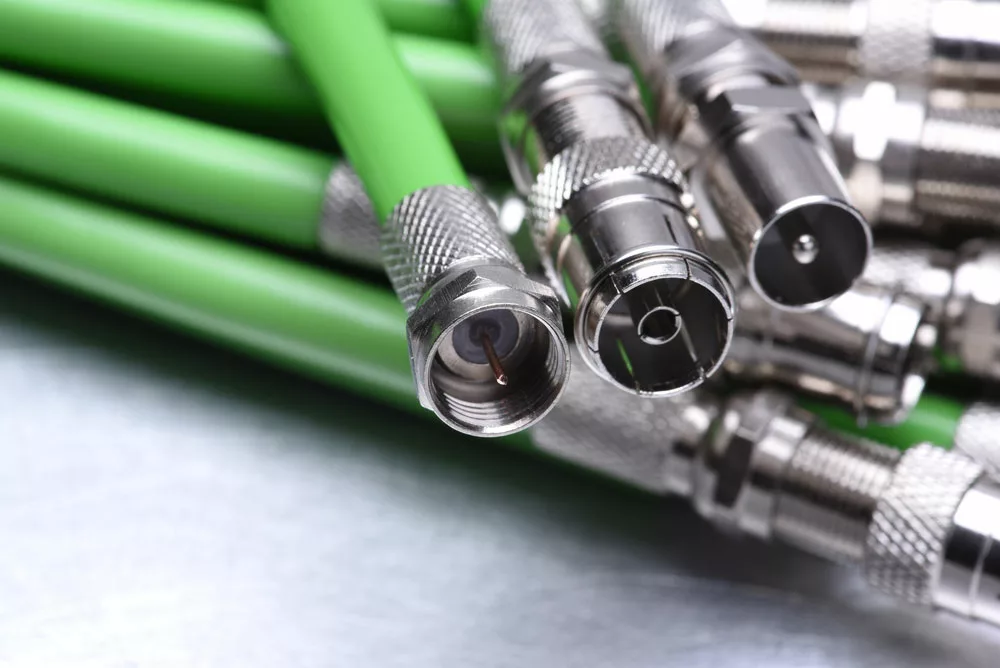Most technologies today have their roots in the past, and the coaxial cable RG is no different. RG (Radio Guide) originates from World War II military specifications. Further, each coaxial cable type features different RG ratings to help indicate unique characteristics and specifications.
However, it’s almost impossible to generalize different coaxial RG cables as the designated numbers are slightly random. Also, the numbers don’t always indicate the type’s form and function. Moreover, numbers indicate cables that don’t match the original Radio Guide specifications.
While each RG cable provides various capabilities, this article will discuss the common ones and explore their functions.
Table of Contents
- What are Radio Guide Coaxial Cables?
- What are the Different Types of RG Cables?
- What Makes These RG Cables Different?
- Rounding Up
What are Radio Guide Coaxial Cables?

Green RG coax cables
Coaxial cables are wires hosting two conductors on a shared axis, with one surrounding the other and a dielectric insulator separation. Typically, manufacturers wrap the inner pieces of this cord with metallic shields and synthetic outer jackets.
Coax cables are the go-to for high-frequency signal transmission in cable television, commercial radio, and broadband ethernet. However, you can find them in other commercial and residential applications.
RG cable designs offer different shielding, dielectric, jacket, and center conductor types, depending on the function you need.
What are the Different Types of RG Cables?

A plugged RG cable
Let’s look at the different types of RG cables and their functions:
RG-6
These cables are the standard types for cable television, satellite signal transmission, broadband internet, and other general utility use. Also, you can use RG-6 wires for high frequencies (above 50MHz) applications. Further, they’re thin and flexible enough to bend for residential installations.
In addition, these cables comprise an 18 AWG center conductor for superior signal quality, thick dielectric insulations & strong shielding to stop electric currents from damaging sensitive devices.
RG-59
Unlike RG-6, this coax cable features thinner insulation & shielding and a lighter AWG center conductor. Further, RG-59 cables have designs capable of delivering frequencies below 50MHz.
However, due to their low signal quality, RG-59 cables are ideal for CCTV transmission and short runs, like security and video surveillance cameras.
RG-11
In contrast to the previous RG cables, these variants are thick and inflexible, allowing you to minimize signal losses on long-run applications. Typically, you’d need to run RG-11 cables outside or underground. For instance, you can place these coax cables in your front yard.
What Makes These RG Cables Different?

RG cables on circuit boards
RG-6 coax cables are your go-to for Baseband near signal transmission distances. As a result, they’re one of the best options for transmitting observing camera data and connecting indoor television equipment.
On the other hand, RG-11 coax cables are ideal for Wide Broadband with sizeable signal transmission distances. You can use this cable branch as the main cable line in transmitting cable television signals, camera data, and other high-frequency applications.
Lastly, RG-59 comes with intertwined multi-small fibers, which makes it flexible. Hence, they’re best suited for observing cameras in small spaces, like elevators, and are ideal for analog cameras.
Although RG-11 and RG6 coax cables have similar functions and applications, they differ. Hence, it would be best if you considered some differences before choosing one over the other. But what are the significant differences between them?
- RG-11 features lower attenuation levels compared to RG6 cables
- RG-11 cables can transmit lower-frequency signals better than RG-6 variants.
- Due to RG-11’s lower attenuation levels, you can use them for long-range transmissions up to 1,100m. In contrast, RG-6 cables can only transmit over 600m.
Rounding Up
RG6 cables are more popular than RG-59 and RG-11. Also, they’re more versatile and can handle higher frequencies without suffering signal losses. However, RG-58 and RG-11 coax cables are still widespread for various commercial and residential applications.
Also, RG-6 and RG-11 are more expensive than RG-59, depending on your use. So, it’s crucial to ensure that your cable of choice rhymes with the load and impedance of the source linked to your application.
We recommend opting for high-quality cables from reputable manufacturers over buying cheap fakes.
Do you have more questions? Feel free to ask, and we’ll be happy to help.
